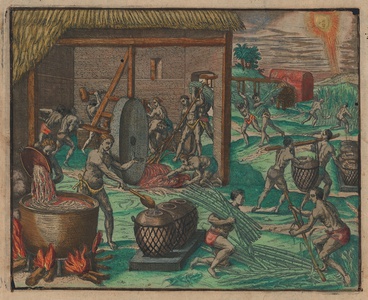| Method | Copper engraving with early hand colouring |
| Artist | Theodor de Bry |
| Published | [Frankfurt-am-Main, c.1595] |
| Dimensions | Image and Plate 160 x 195 mm, Sheet 315 x 235 mm |
| Notes |
An illustration of slavery in the Caribbean, engraved by de Bry after drawings by Stradanus for the fifth volume of the Grands Voyages, presented in full early hand colouring. The plate is one of the very earliest known depictions of sugar production in the Americas. As the title and descriptive text below explain, following the near eradication of the indigenous population of Hispaniola, the Spanish brought in large numbers of African slaves to mine precious metals. When the veins of silver and gold were exhausted, the Spanish turned to sugar production. This view shows the process. Groups of slaves cut the sugar cane from the fields and carry bundles to a workshop, where the canes are stripped, burnt, crushed, and boiled in a large cauldron, before the unrefined sugar is ladled into large earthenware jars. de Bry's fifth volume was essentially an illustrated edition of Girolamo Benzoni's Voyages. A Milanese explorer, Benzoni (c.1519-after 1572) spent 15 years travelling through the Spanish controlled areas of the Americas including the West Indies, Central America, and South America. After losing his fortune in a shipwreck, Benzoni returned to Italy penniless, and realised his only marketable asset was his experiences in the New World. Thus, he wrote Historia del Mondo Nuovo, which was published in Venice in 1565. His book eventually ran to eleven editions. Text below image reads: 'Nigritarum ergo opera usi sunt Hispani initio in scrutandis venis metallicis: verum post quam illae fuerunt exhaustae, horum ministerio uti coeperunt ad molas trusatiles quae sacchariferas cannas comminuunt, ad saccharum coquendum & cogendum: in quo ministerio etiamnum hodie magna ex parte occupantur. Nam cum ea Insula humida sit & calida, minimo negotio sacchariferae cannae sive arundines succrescunt; ex quibus contusis, deinde in lebetes coniectis, & decoctis, postremum rite repurgatis & in saccharum concretis, magnum quaestum facere solent. Utuntur praeterea istorum Nigritarum opera in pascendis armentis, & reliquis rebus administrandis quae necessariae sunt ad suos usus.' Theodor de Bry (1528-1598) was a Flemish-born engraver and editor, who travelled Europe. De Bry fled from Liège in fear of the Spanish persecution of Protestants, lived in Strasbourg, travelled to Antwerp, then London, and finally settled in Frankfurt-am-Main, where he started a publishing business and printing workshop. de Bry's seminal work The Great and Small Voyages drew together contemporary narratives of exploration. Inspired and encourged by the English author Richard Hakluyt, de Bry completed the first part in 1590, and went on to publish five further parts before his death in 1598, when his wife and sons, Johann Theodor and Johann Israel, took over the task of completing the series. Immediately popular, drawing together a huge amount of material and in many cases providing the first readily available imagery of the new world and its inhabitants, this work and its illustrations provided the iconography and narrative of the peoples and customs of the Americas and the New World. The illustrations in the Voyages were in many cases based on existing images, but in many cases the images were altered to reflect European conventions, giving native peoples classical proportions and attributes. Jan van der Straet or Giovanni Stradano, more commonly known as Stradanus (1523-1605) was a Flemish mannerist painter and designer of prints and tapestries. Born in Bruges in 1523, he received early instruction from his father, went on to train in Antwerp under Pieter Aertsen and became a master in city's Guild of St Luke in 1545. He moved to Florence where he entered the service of the Medici Dukes and Giorgio Vasari. Collaborations with Hieronymus Cock and the Galle family resulted in many of his works, such as his popular series of hunting scenes, being published as copper engravings. Condition: Verdigris and associated paper thinning and corrosion from old hand colour. Uniform time toning to sheet. Binders creases to left margin. Chips and stains to margins, not affecting image or text. Latin letterpress title above and text below. Blank on verso. |
| Framing | unmounted |
| Price | £225.00 |
| Stock ID | 52637 |

